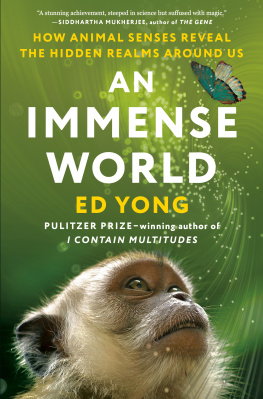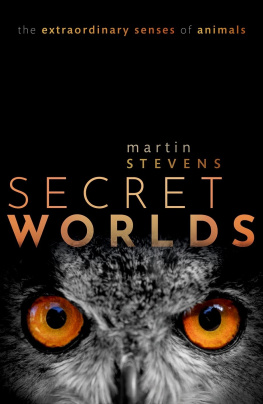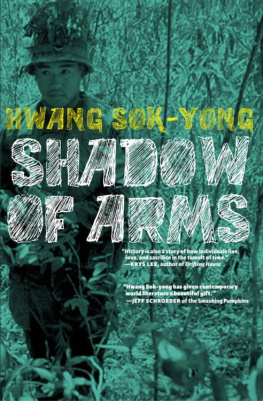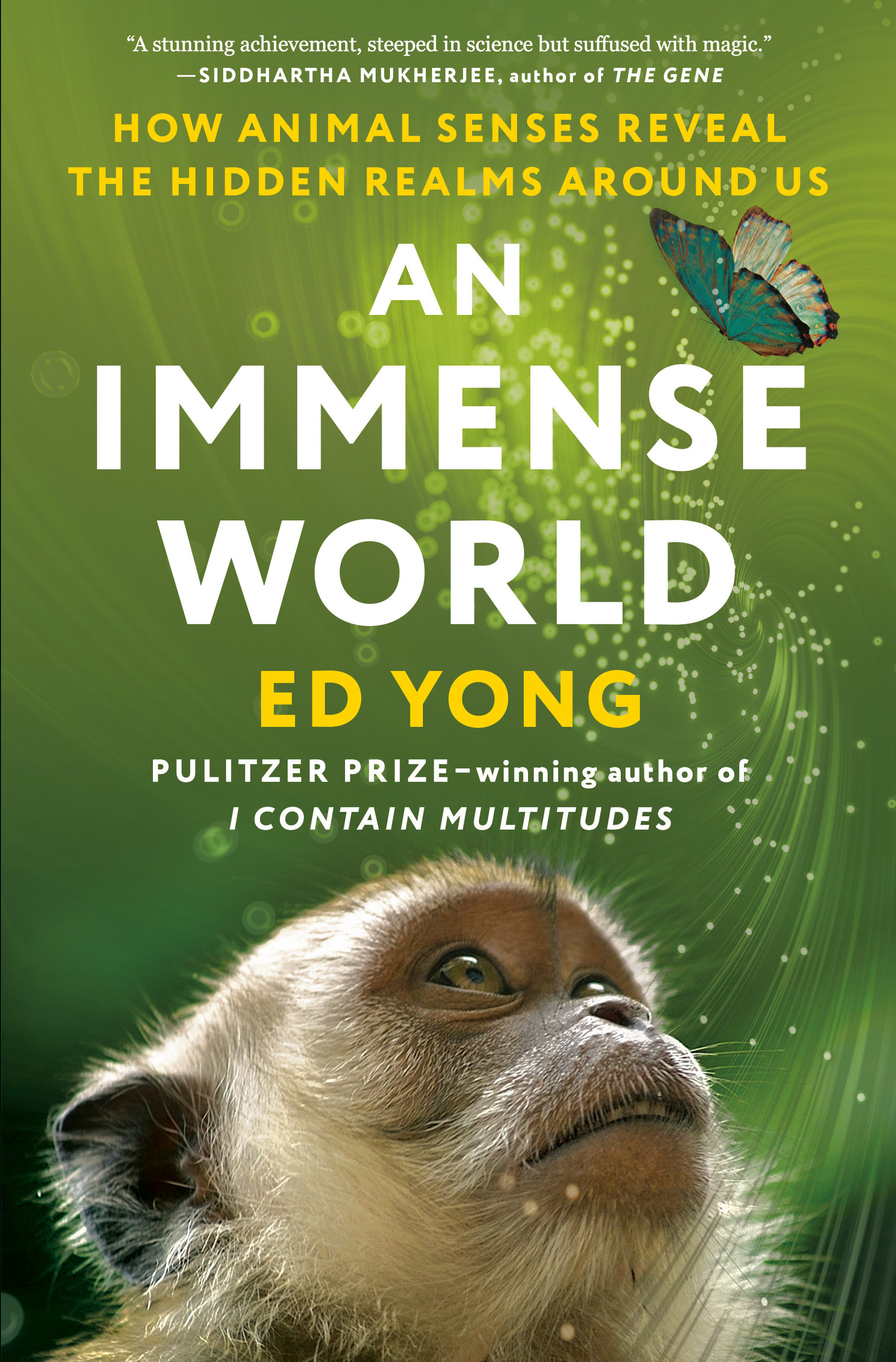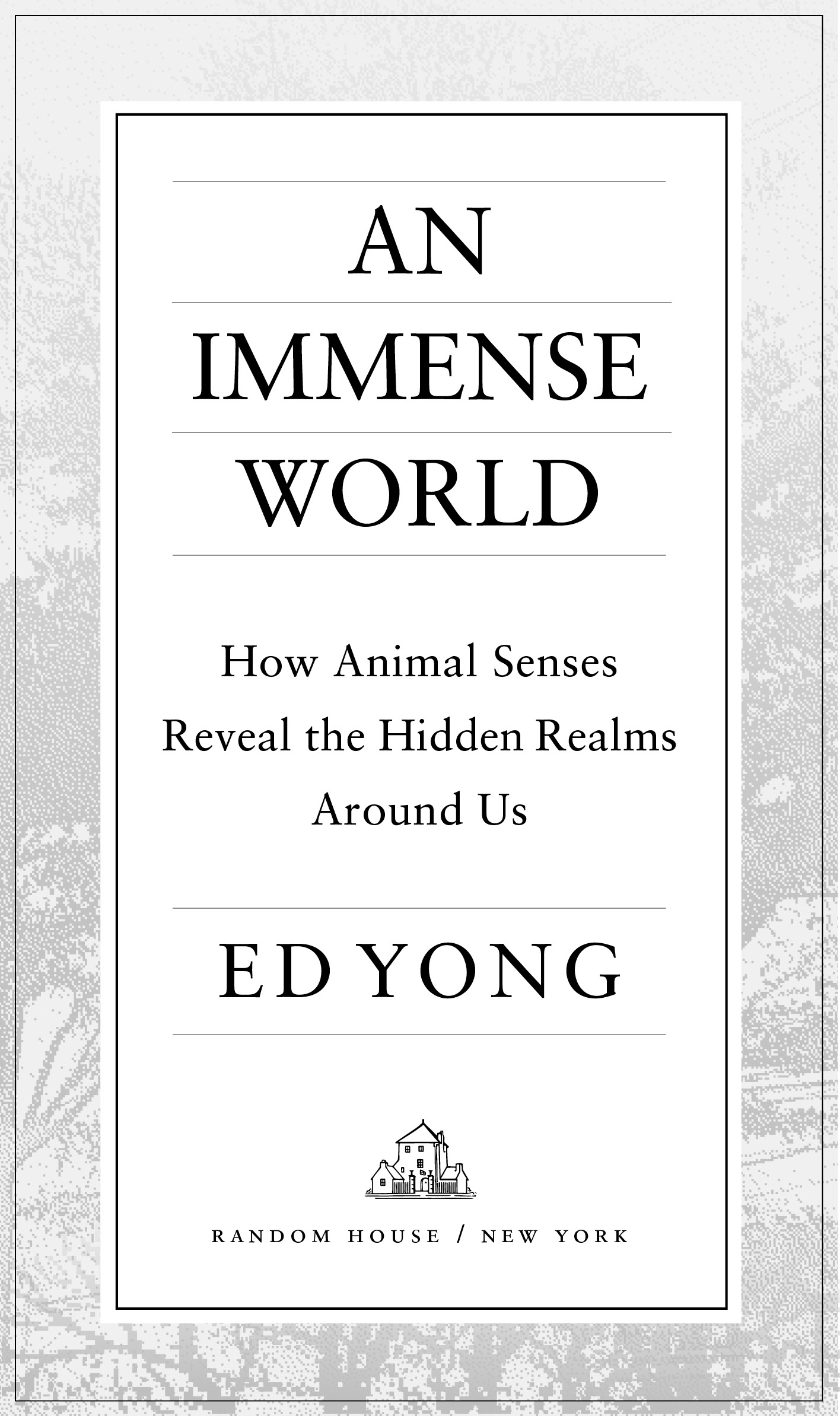All rights reserved.
Published in the United States by Random House, an imprint and division of Penguin Random House LLC, New York.
Random House and the House colophon are registered trademarks of Penguin Random House LLC.
Names: Yong, Ed, author. Title: An immense world : how animal senses reveal the hidden realms around us / Ed Yong. Description: New York : Random House, 2022. | Includes bibliographical references and index. Identifiers: LCCN 2021046048 (print) | LCCN 2021046049 (ebook) | ISBN 9780593133231 (hardcover) | ISBN 9780593133248 (ebook) Subjects: LCSH: Senses and sensation. | Animal behavior. | Physiology. | Neurosciences. Classification: LCC QP431 .Y68 2022 (print) | LCC QP431 (ebook) | DDC 591.5dc23/eng/20211221
Introduction
The Only True Voyage
Imagine an elephant in a room. This elephant is not the proverbial weighty issue but an actual weighty mammal. Imagine the room is spacious enough to accommodate it; make it a school gym. Now imagine a mouse has scurried in, too. A robin hops alongside it. An owl perches on an overhead beam. A bat hangs upside down from the ceiling. A rattlesnake slithers along the floor. A spider has spun a web in a corner. A mosquito buzzes through the air. A bumblebee sits upon a potted sunflower. Finally, in the midst of this increasingly crowded hypothetical space, add a human. Lets call her Rebecca. Shes sighted, curious, and (thankfully) fond of animals. Dont worry about how she got herself into this mess. Never mind what all these animals are doing in a gym. Consider, instead, how Rebecca and the rest of this imaginary menagerie might perceive one another.
The elephant raises its trunk like a periscope, the rattlesnake flicks out its tongue, and the mosquito cuts through the air with its antennae. All three are smelling the space around them, taking in the floating scents. The elephant sniffs nothing of note. The rattlesnake detects the trail of the mouse, and coils its body in ambush. The mosquito smells the alluring carbon dioxide on Rebeccas breath and the aroma of her skin. It lands on her arm, ready for a meal, but before it can bite, she swats it awayand her slap disturbs the mouse. It squeaks in alarm, at a pitch that is audible to the bat but too high for the elephant to hear. The elephant, meanwhile, unleashes a deep, thunderous rumble too low-pitched for the mouses ears or the bats but felt by the vibration-sensitive belly of the rattlesnake. Rebecca, who is oblivious to both the ultrasonic mouse squeaks and the infrasonic elephant rumbles, listens instead to the robin, which is singing at frequencies better suited to her ears. But her hearing is too slow to pick out all the complexities that the bird encodes within its tune.
The robins chest looks red to Rebecca but not to the elephant, whose eyes are limited to shades of blue and yellow. The bumblebee cant see red, either, but it is sensitive to the ultraviolet hues that lie beyond the opposite end of the rainbow. The sunflower it sits upon has at its center an ultraviolet bullseye, which grabs the attention of both the bird and the bee. The bullseye is invisible to Rebecca, who thinks the flower is only yellow. Her eyes are the sharpest in the room; unlike the elephant or the bee, she can spot the small spider sitting upon its web. But she stops seeing much of anything when the lights in the room go out.
Plunged into darkness, Rebecca walks slowly forward, arms outstretched, hoping to feel obstacles in her way. The mouse does the same but with the whiskers on its face, which it sweeps back and forth several times a second to map its surroundings. As it skitters between Rebeccas feet, its footsteps are too faint for her to hear, but they are easily audible to the owl perched overhead. The disc of stiff feathers on the owls face funnels sounds toward its sensitive ears, one of which is slightly higher than the other. Thanks to this asymmetry, the owl can pinpoint the source of the mouses skittering in both the vertical and horizontal planes. It swoops in, just as the mouse blunders within range of the waiting rattlesnake. Using two pits on its snout, the snake can sense the infrared radiation that emanates from warm objects. It effectively sees in heat, and the mouses body blazes like a beacon. The snake strikesand collides with the swooping owl.
All of this commotion goes unnoticed by the spider, which barely hears or sees the participants. Its world is almost entirely defined by the vibrations coursing through its weba self-made trap that acts as an extension of its senses. When the mosquito strays into the silken strands, the spider detects the telltale vibrations of struggling prey and moves in for the kill. But as it attacks, it is unaware of the high-frequency sound waves that are hitting its body and bouncing back to the creature that sent themthe bat. The bats sonar is so acute that it not only finds the spider in the dark but pinpoints it precisely enough to pluck it from its web.
As the bat feeds, the robin feels a familiar attraction that most of the other animals cannot sense. The days are getting colder, and it is time to migrate to warmer southern climes. Even within the enclosed gym, the robin can feel Earths magnetic field, and, guided by its internal compass, it points due south and escapes through a window. It leaves behind one elephant, one bat, one bumblebee, one rattlesnake, one slightly ruffled owl, one extremely fortunate mouse, and one Rebecca. These seven creatures share the same physical space but experience it in wildly and wondrously different ways. The same is true for the billions of other animal species on the planet and the countless individuals within those species. Earth teems with sights and textures, sounds and vibrations, smells and tastes, electric and magnetic fields. But every animal can only tap into a small fraction of realitys fullness. Each is enclosed within its own unique sensory bubble, perceiving but a tiny sliver of an immense world.
There is a wonderful word for this sensory bubbleUmwelt. It was defined and popularized by the Baltic-German zoologist Jakob von Uexkll in 1909. Umwelt comes from the German word for environment, but Uexkll didnt use it simply to refer to an animals surroundings. Instead, an Umwelt is specifically the part of those surroundings that an animal can sense and experienceits perceptual world. Like the occupants of our imaginary room, a multitude of creatures could be standing in the same physical space and have completely different Umwelten. A tick, questing for mammalian blood, cares about body heat, the touch of hair, and the odor of butyric acid that emanates from skin. These three things constitute its Umwelt. Trees of green, red roses too, skies of blue, and clouds of whitethese are not part of its wonderful world. The tick doesnt willfully ignore them. It simply cannot sense them and doesnt know they exist.

